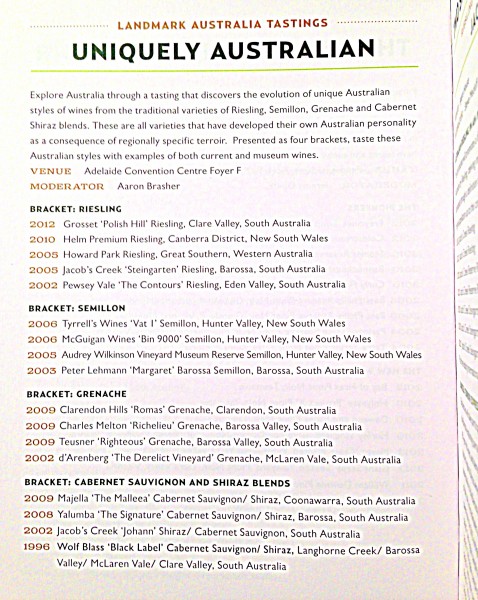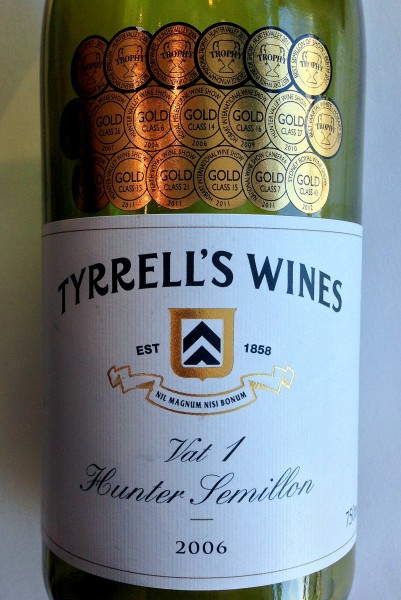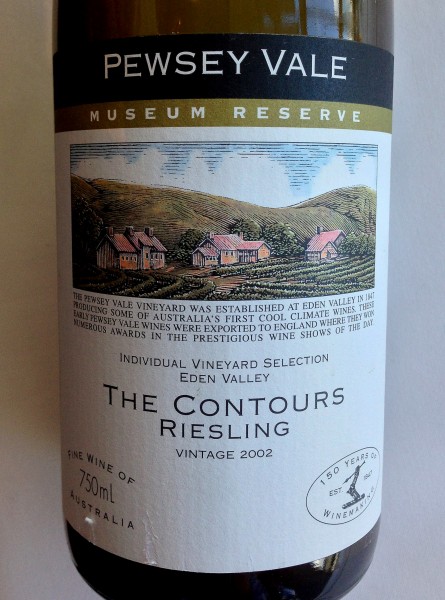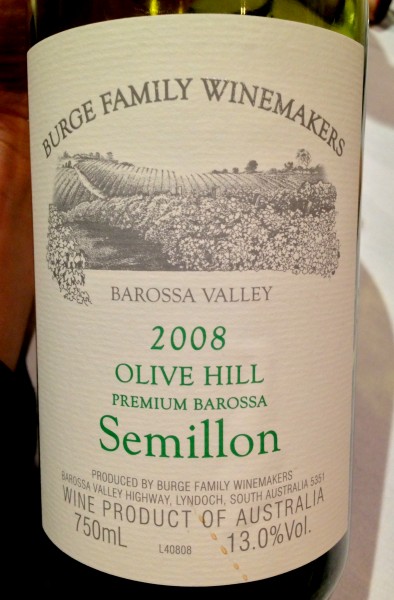Savour Australia Day 1: Uniquely Australian
Posted on 7 October 2013
I was assigned to the Shiraz the Australian way Landmark tasting on the first day of Savour Australia. But I am sucker for good tastings and so finished the Shirazes quickly to run and sneak into another Landmark: Uniquely Australian.
It was worth it. I didn’t hear the presentation, chaired by Aaron Brasher, but the line-up of wines was brilliant, organised into four brackets supposed to illustrate “uniquely Australian” styles: Semillon, Riesling, Grenache, and Cabernet–Shiraz blends. I am using quotation marks because in all truth, three of four are not unique in any sense. Germany, Austria, Alsace and a host of other regions make dry Riesling as good (often better) as Australian Riesling. Grenache is hardly unique to Australia, and there is currently a Grenache revolution going on in north-eastern Spain as well as a continuous refinement of Grenache styles in the Rhône. Australia does have one major asset here: its old Grenache vineyards, dozens of hectares of vines going back to the 1880s and some as old as 1848. Old vines are a good place to start (incidentally Tim Atkin MW just published this column pretty much echoing my views) but speaking about the sheer quality in the glass, I wouldn’t exactly say Australia Grenache overperforms at the moment.
 Cab–Shiraz, the grape blend responsible for many of Australia’s commercial successes, is also not “unique”: it has been the traditional combo of Provence for decades, admittedly not the sexiest wine region out there but with some great wines such as Domaine de Trévallon.
Cab–Shiraz, the grape blend responsible for many of Australia’s commercial successes, is also not “unique”: it has been the traditional combo of Provence for decades, admittedly not the sexiest wine region out there but with some great wines such as Domaine de Trévallon.
In the end, if there is a distinctive style of wine out of these four you won’t find anywhere else, it has to be Se(é)millon. The Bordeaux grape is hardly ever made into a varietal dry wine in its homeland, being normally blended with (increasing amounts of) Sauvignon Blanc. In Australia, it shines alone. And the wines are really compelling: somewhat shy in their youth, brimming with energetic citrusy acidity, they develop a lovely complexity with six or seven years in the bottle. The bouquet becomes quite idiosyncratic: the fruit fades away and beeswax, honey, wet wool and ripe cheese make an appearance. It could be too much of a good thing but that cheesy savouriness is supported by citrusy freshness, and the whole works well.
We tasted the following wines at the Landmark tasting:
Grosset Polish Hill Riesling 2012 (Clare): Very citrusy and rather lean at this stage, way too young. I would perhaps like more flesh.
Helm Premium Riesling 2010 (ACT): First time I tasted this. Aromatic and fruity but acidity is very punchy.
Howard Park Riesling 2005 (Western Australia): Semi-aged, just off-dry – a happy balance. Graceful. An excellent surprise.
Jacob’s Creek Steingarten Riesling 2005 (Eden): Waxy forest floor nose, broad and mealy on palate. No great impression though it did show better here.
Pewsey Vale The Contours Riesling Museum Release 2002 (Eden): This is just beautiful, complex and subtle. The finest acids of any Australian Riesling.
Tyrrell’s Vat 1 Hunter Semillon 2006 (Hunter): Surprisingly crisp and tight for its age. Just some complexity but needs more time!
McGuigan Bin 9000 Semillon 2006 (Hunter): Quite caramelly and broad, not very long, lacks punch.
Audrey Wilkinson Museum Release Semillon 2005 (Hunter): Petrolly and slightly reduced. Has power but not subtlety. Will go on for another 5+ years.
Peter Lehmann Margaret Semillon 2003 (Barossa): Nice broad fruit but a little drying on end. Lacks poise, as other Semillons here. Very good, not more.
Clarendon Hills Romas Grenache 2009 (McLaren Vale): Massive concentration and ripeness of pruney fruit, impressive if controversial in style.
Charles Melton Richelieu Grenache 2009 (Barossa): Big overdone Grenache in need of bottle age. Forceful but promising.
Teusner Righteous Grenache 2009 (Barossa): Impressive concentration of prunes and chocolate. Goes all the Grenache way but somehow a good balance. Cork closure.
d’Arenberg The Derelict Vineyard Grenache 2002 (McLaren Vale): Very Aussie in the gum tree notes. Full-flavoured with vegetal streak underneath. Has aged well.
Majella The Malleea Cab–Shiraz 2009 (Coonawarra): didn’t get to taste it!
Yalumba The Signature Cab–Shiraz 2008 (Barossa): A 1990s Aussie style with plenty of gum tree and sweet ham nose. Then Cabernet tannins kick back. Huge wine but does it have the harmony?
Jacob’s Creek Johann Shiraz–Cab 2002 (SA): Less of a wild grizzly than the above, has mellowed with age into a textured, engaging, coffeed whole. And crisp too.
Wolf Blass Black Label Cab–Shiraz 1996 (SA): Respectable for a 17-year-old wine. Big meaty, earthy style. Likely was an undrinkable monster up the road. Perhaps too much?
Semillon is definitely an Australian wine to explore. And I’ll come back to Riesling in my report from Clare Valley.
Disclosure: my trip to Australia including flights, accommodation and wine tasting programme was sponsored by Wine Australia.






